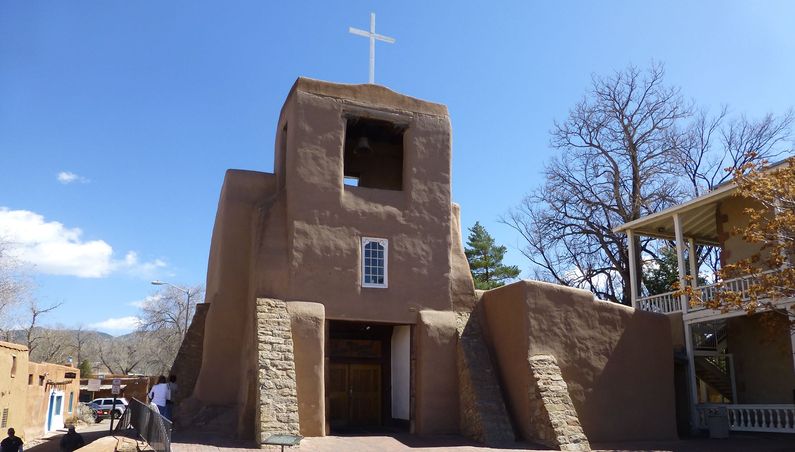Mission San Miguel (2)
|
Mission San Miguel (2) (1610-1830s) - A Spanish mission established in 1610 by Fray Alonso de Benavides, OFM, in present day Santa Fe, Santa Fe County, New Mexico. Destroyed and rebuilt several times and abandoned during the Pueblo Revolt (1680-1692). Reestablished in 1710 and continued as a mission until the 1830s. Only the church remains today.
The Spanish Period (1598-1821)Juan de Onate officially established the name New Mexico when he was appointed the first governor of the new Province in 1598. Onate extended the El Camino Real de Tierra Adentro, "Royal Road of the Interior," from Santa Barbara, Chihuahua into New Mexico opening it up for settlers and missionaries. The indigenous people of the new province were the Pueblo peoples and groups of Navajo, Apache and Utes. The villages of these people became known to the Spanish as Pueblos. The early missionaries sought to establish missions at each of the major pueblos and attempt to form the indigenous peoples into european like communities bring them into the catholic religion. The Mission San Miguel was founded in 1610 by Fray Alonso de Benavides, OFM, in present day Santa Fe then known as La Villa Real de Santa Fe de San Francisco de Asis (Villa Santa Fe). The establishment of Villa Santa Fe included a presidio and six districts around a central plaza. The presidio included the Palace of Governors, a fortified barracks north of the palace and a Plas de Arms (later Fort Marcy under the Americans). The original church chapel was built on the site of an ancient kiva of the Analco Indians. It was the Spanish custom to build their mission churches on top of the kivas to cover over this symbol of the native religion. The mission and church originally served a small group of Tlaxcalan Indians, laborers, and Spanish soldiers who lived on the south side of the Santa Fe River. The mission was 500 yards south of the central plaza across the Rio Santa Fe and outside the defenses of the Presidio. The mission chapel was destroyed in 1640 and rebuilt in 1645. During the Pueblo Revolt in 1680 that drove the Spanish from New Mexico it was destroyed again and not rebuilt until 1710, well after the Spanish regained control of New Mexico in 1692. Mexican Period (1822-1846)The Mexican Revolution transitioned New Mexico from Spanish rule to Mexican Rule circa 1822. It was during the Mexican period that the role of the mission changed to a purely religious one and the mission lands were reduced to property around the church and associated cemeteries. The Mexican government instituted a secularization program for the missions that confiscated mission property and sought to remove all Spanish missionaries. The American Period (1848-Present)The Mexican War was declared by the U.S. Congress on 11 May 1846 in response to a Mexican attack on U.S. troops in Texas. The declaration of war opened the door for American occupation of New Mexico and U.S. forces occupied Santa Fe in August 1846. Portions of the Presido were incorporated into the U.S. Fort Marcy. In 1859 Archbishop Jean Baptist Lamy purchased the Chapel and adjacent land for the De LaSalle Christian Brothers. The Christian Brothers developed a school on the adjacent site. Current StatusThe Mission of San Miguel survives in the church with most other elements gone. The current church dates to the 1710 rebuilding and has had significant modification. The most prominent modifications include the frontal triangular buttresses added about 1888 and the mission adobe look circa 1955.
Sources:
Visited: 21 Mar 2013
| ||||||
